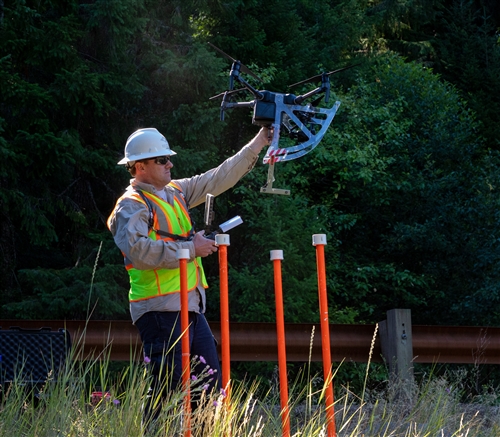Related News
Related News
-
Energy shortfall of 9 gigawatts projected for the Northwest
By 2030, a dry year combined with soaring energy demand during extended cold snaps could lead to rolling blackouts, a new study warns.
Find Out More -
EWEB secures $2.5 billion of reliable, affordable, carbon-free energy for customers
The new contract with EWEB’s largest energy supplier, the Bonneville Power Administration, forms the foundation of a diverse energy portfolio.
Find Out More -
Women in STEM: Meet the Hydro Project Engineer Building Habitat for Salmon
EWEB Engineer Associate Val Chang found her way to the McKenzie River from Los Angeles, inspired by heritage trips to the waters of Taiwan and key mentors along the way.
Find Out More -
Public Power Week Poster Contest Winners 2025
The results are in! View the winning posters from EWEB's 2025 Public Power Week Poster Contest.
Find Out More -
EWEB Hometown Heroes compete internationally
Out of 290 teams from 14 different countries, EWEB's Lineman Rodeo team places in the top third of competitors.
Find Out More -
Vote for your favorite Public Power Week Posters
The top five submittals will receive awards. Help us pick the winners.
Find Out More -
Electric Projects underway in North & South Eugene
Underground lines and disaster-resilient power poles are part of EWEB’s infrastructure upgrade near Eugene’s largest natural resource area.
Find Out More -
The Bonneville Power Administration Rate Change and Your EWEB Bill
BPA’s finalized rate increase is smaller than projected, and EWEB’s pass-through adjustment effective October 1, 2025 will now be 2.7% for residential customers—down from the anticipated 4%.
Find Out More -
EWEB completes helicopter installation of salmon habitat features
EWEB adds downed trees and 2,000 tons of gravel to the Uupper McKenzie River below Tamolitch Falls to improve spawning habitat.
Find Out More -
Court rules in favor of EWEB in Carmen-Smith litigation
The U.S. District Court in Eugene has granted EWEB's motion to dismiss a lawsuit brought under the Endangered Species Act pertaining to fish passage at EWEB’s Trail Bridge Dam. The favorable ruling clears the way for EWEB to continue advancing towards implementation of permanent fish passage at the dam.
Find Out More -
EWEB proposes modified plan for permanent fish passage at Trail Bridge Dam
After eight months of extensive collaboration and analysis with scientific experts at two federal regulatory agencies, EWEB is proposing an improved plan to build permanent fish passage facilities at Trail Bridge Dam on the McKenzie River.
Find Out More -
EWEB prepares for wildfire season with risk mitigation measures
EWEB is building a more resilient electric system to weather various types of disasters, from wildfire to winter storms.
Find Out More -
EWEB, Lane County host open house to gather feedback for “Leaburg Transportation Alternatives Analysis”
“What is the Future of the Leaburg Dam Bridge?” open house exhibit on display at Lloyd Knox Park Visitor Pavilion through July 25
Find Out More -
Improving habitat resiliency throughout the Upper McKenzie
Environmental Responsibility is a core guiding value for EWEB decision-making. This summer, EWEB continues its commitment to environmental stewardship with a robust slate of habitat enhancement updates throughout the upper McKenzie River, across the footprint of the Carmen-Smith Hydroelectric Project.
Find Out More -
EWEB weighs multi-billion-dollar decision affecting energy supply
EWEB is weighing energy supply decisions that will cost nearly $2 billion over the next two decades.
Find Out More - Show More
Fake Geese, Drones, and Glow-in-the-Dark Markers: How EWEB Protects Birds from Powerlines
June 24, 2022

When EWEB began receiving reports of Canada Geese refusing to leave our powerline poles in the McKenzie Valley, EWEB Environmental Specialist Andrew Janos knew his Osprey Protection Program was a success.
The fake geese are meant to prevent Osprey from setting up nests on cross arms – but in this case, they tricked some people, too!
“If you have ever had an angry Canada Goose charge you, you’ll know how fearless and determined they can be, and bullying Osprey out of their nests is quite common,” Janos said, explaining his goose decoy program. “Due to the fact that they typically nest before Osprey (in February vs. March-April), they often beat to the Osprey to their own nests and lay eggs in them. Based on this observed blatant intimidation, utilities have been putting up decoys for a while as a general deterrent to nesting Ospreys/raptors.”
EWEB has constructed Osprey nesting platforms throughout the McKenzie Valley, but sometimes Osprey try to build a nest on top of cross arms. If allowed, the sticks and debris can create a fire hazard and cause power outages – and puts the birds at risk.
“There are official perch/nesting deterrents on the market, but why not use something that is biologically recognizable to the birds and a conversation piece?” Janos said.
The goose decoys are just one of the many ways EWEB works to protect migrating birds and waterfowl. Last summer, EWEB installed brightly-colored markers on powerlines over water crossings to help birds see the powerlines and avoid flying into them.
Installing these bird flight diverters is part of EWEB’s greater environmental mitigation requirements for relicensing the Carmen-Smith Hydroelectric Project, along with other fisheries and wildlife. EWEB worked with biologist JD Dwyer to install approximately 140 markers across 8 water crossings.
Dwyer used a drone to attach the markers. This new method is both more cost-effective and safer than installing them by helicopter, which is how they're usually installed.
In his graduate research, Dwyer helped develop this drone deployment method, along with other avian avoidance systems.
“We have flown drones all across the country. We’ve done it in about 4 or 5 states,” he said. “It is very rewarding, because as biologists, so often we’re just monitoring something dying. So it is nice to be able to have an actual, real impact.”
Along with preventing bird collisions, EWEB is improving the Carmen-Smith Hydroelectric Project area by establishing fish passage for endangered bull trout and Chinook salmon, and building an improved spawning channel for salmonids.
“It's important to know for EWEB customers and ratepayers that this is one of the several examples of EWEB’s environmental commitment to protecting both wildlife and fisheries within our service area,” Janos said.

